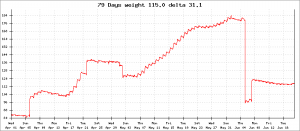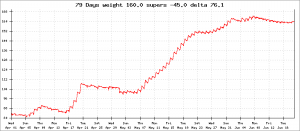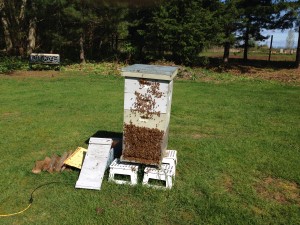Interpreting the graphs
The biggest problem with getting a continuous graph of hive progress is what we call ‘beekeeper interference’. Beekeepers put empty supers on hives, then later remove them when full. If we ran a graph of the hive weight without adjustments for beekeeper interference, it would look like this:-

The problem with this graph, the large jumps as we add and remove supers make it difficult to interpret the information we are looking for, which is the daily change in hive weight due to activity of the bees, without mind for the activity of the beekeeper. To solve this problem, we make adjustments on the fly by tracking the weight of equipment added and removed, so the final graph is a continuous line. A graph of the same time period with ‘beekeeper interference’ removed.
 Background
Background
When we moved to the new property, one of the first things we started to ask, what are the flows like in this area, compared to the area we came from. We ran into that same old issue beekeepers often discover, we asked 3 beekeepers, and got 3 different answers. Our solution to that conundrum, was to ask the bees instead. To ask the bees about local flows, we put a hive on a scale, it’s a fairly simple setup using an off the shelf inexpensive platform scale, with a tiny computer connected that takes the readings and stores them into a database for processing to produce the graphs. At the time it was set up, we had spare nuc box, so we put the computer inside that beside the hive to protect it from the weather.
Before the back lot was fully prepared, we had all the hives on the lawn out back, and I spent some hours going over records to choose which hive would be the best one to put on the scale. In the end, reality trumped all my careful planning, and the hive that went on the scale was determined by the length of the extension cord. Ah well, reality often trumps theory in such cases. By the time we were done, this is what we had:-

We have learned a lot from the scale data, and it has caused us to completely change the way we approach managing the bees to produce honey.
 The problem with this graph, the large jumps as we add and remove supers make it difficult to interpret the information we are looking for, which is the daily change in hive weight due to activity of the bees, without mind for the activity of the beekeeper. To solve this problem, we make adjustments on the fly by tracking the weight of equipment added and removed, so the final graph is a continuous line. A graph of the same time period with ‘beekeeper interference’ removed.
The problem with this graph, the large jumps as we add and remove supers make it difficult to interpret the information we are looking for, which is the daily change in hive weight due to activity of the bees, without mind for the activity of the beekeeper. To solve this problem, we make adjustments on the fly by tracking the weight of equipment added and removed, so the final graph is a continuous line. A graph of the same time period with ‘beekeeper interference’ removed.
 Background
When we moved to the new property, one of the first things we started to ask, what are the flows like in this area, compared to the area we came from. We ran into that same old issue beekeepers often discover, we asked 3 beekeepers, and got 3 different answers. Our solution to that conundrum, was to ask the bees instead. To ask the bees about local flows, we put a hive on a scale, it’s a fairly simple setup using an off the shelf inexpensive platform scale, with a tiny computer connected that takes the readings and stores them into a database for processing to produce the graphs. At the time it was set up, we had spare nuc box, so we put the computer inside that beside the hive to protect it from the weather.
Before the back lot was fully prepared, we had all the hives on the lawn out back, and I spent some hours going over records to choose which hive would be the best one to put on the scale. In the end, reality trumped all my careful planning, and the hive that went on the scale was determined by the length of the extension cord. Ah well, reality often trumps theory in such cases. By the time we were done, this is what we had:-
Background
When we moved to the new property, one of the first things we started to ask, what are the flows like in this area, compared to the area we came from. We ran into that same old issue beekeepers often discover, we asked 3 beekeepers, and got 3 different answers. Our solution to that conundrum, was to ask the bees instead. To ask the bees about local flows, we put a hive on a scale, it’s a fairly simple setup using an off the shelf inexpensive platform scale, with a tiny computer connected that takes the readings and stores them into a database for processing to produce the graphs. At the time it was set up, we had spare nuc box, so we put the computer inside that beside the hive to protect it from the weather.
Before the back lot was fully prepared, we had all the hives on the lawn out back, and I spent some hours going over records to choose which hive would be the best one to put on the scale. In the end, reality trumped all my careful planning, and the hive that went on the scale was determined by the length of the extension cord. Ah well, reality often trumps theory in such cases. By the time we were done, this is what we had:-
 We have learned a lot from the scale data, and it has caused us to completely change the way we approach managing the bees to produce honey.
We have learned a lot from the scale data, and it has caused us to completely change the way we approach managing the bees to produce honey. 